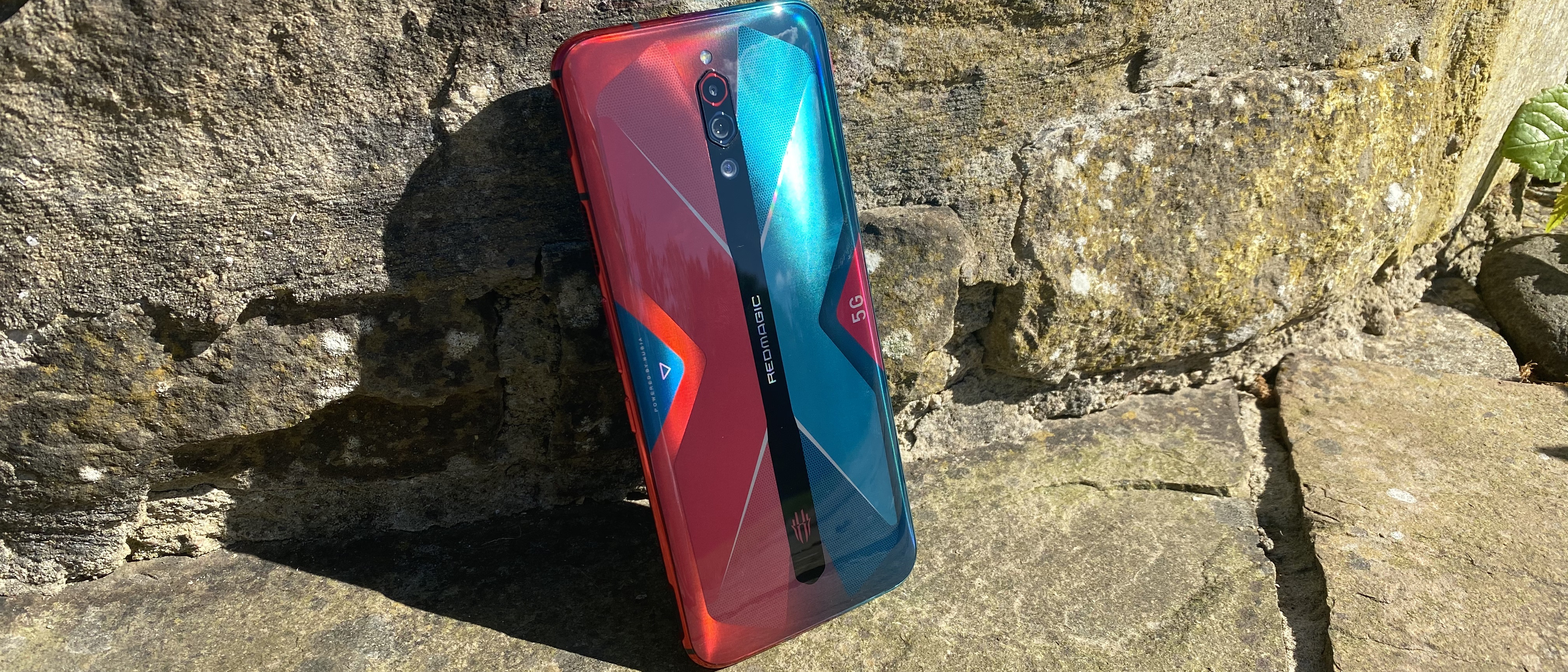Tom's Guide Verdict
Its looks are loud and brash, but the RedMagic 5G has the performance to back them up at a surprisingly low price, although that's achieved by skipping some premium features its rivals include.
Pros
- +
Class-leading 144Hz display
- +
Strong performance
- +
Long battery life and fast charging
- +
Reasonably priced
Cons
- -
Love-or-hate design
- -
Weak photography
- -
Gaming features add a lot of weight
Why you can trust Tom's Guide
One look at the RedMagic 5G’s striking looks and unique features, and it’s clear this isn’t a gaming phone you can easily ignore. What you also shouldn't ignore is what this supposedly specialized phone can offer you as an average smartphone user looking for your next flagship device.
Gaming phones are still a niche within the wider smartphone market, but they can benefit more than just Fortnite fans and the like. With their large displays, powerful chipsets and endless customizability, they also tick boxes that are relevant to more mainstream customers. While the RedMagic 5G isn't a luxurious device made with premium materials or meticulously-designed software, it will do what you need it to do, whether that’s work or play, with power to spare. It even delivers a few class-leading features, like its super-smooth 144Hz display and in-built cooling fan.
- The best phones to buy now
- Check out the best gaming phones
An unfortunate fact of the smartphone market is that to get a lot of power, you typically need to pay out. Phones that break this trend, like the iPhone SE 2020, are rare values, and our RedMagic 5G review found a handset that is appealing for similar reasons. This is a phone that might just make you reconsider why anyone would pay so much for similar offerings from Samsung or OnePlus. And while it’s not a perfect replacement for those brands’ flagships by any stretch, it is a worthy alternative that ranks among the best Android phones you can buy today.
Starting price: $579/£539
Display (resolution): 6.65-inch FHD+ AMOLED, up to 144Hz (2340 x 1080)
CPU: Qualcomm Snapdragon 865
RAM: 8GB/12GB
Storage: 128GB/256GB
MicroSD?: No
Rear Cameras: 64MP main, 8MP ultrawide, 2MP macro
Front Camera: 8MP
Water resistance: Not rated
Battery size: 4,500 mAh
Charging: 18W, up to 55W
Size: 168 x 78 x 9.75mm (6.6 x 3.07 x 0.38 inches)
Weight: 218g (7.68 ounces)
Colors: Red/Blue, Red, Black
RedMagic 5G Price and availability
The only place to get a RedMagic 5G is from the RedMagic website itself, but it ships to both the U.S. and the U.K.. The basic model, available either in Hot Rod Red or Eclipse Black, has 8GB RAM and 128GB of storage for $579/£539. It will cost $649/£599 for the more expensive version, which only comes in the red/blue Pulse color combination, but offers 12GB RAM and 256GB storage instead.
The Eclipse Black and Pulse versions are both currently available for purchase, while Hot Rod Red is still “coming soon” according to RedMagic’s website, with no date given for its release.
RedMagic 5G design
It's unlikely to be controversial to say the outer casing of the 5G is very loud. This color option, officially called Pulse, is perhaps the most striking color combination I've seen on a phone in a long time. Whether that's a good thing will depend on your personal preference, but its dual colors and shiny glass back are pretty much the antithesis of the subtle metallic tones that most premium smartphone manufacturers go for. If this color combo is too much for you, there are all-black or all-red options available, but only with the lesser of the two available specs configurations.
On the back, there's the prerequisite RGB lighting, but it's fairly subtle. It’s constrained only to the transparent RedMagic logotype and in the center of the phone and the company logo in the bottom center, and you can turn it off if you find it annoying. If you leave it on, though, it can act as an alert light to tell you when you've got a notification.
Get instant access to breaking news, the hottest reviews, great deals and helpful tips.
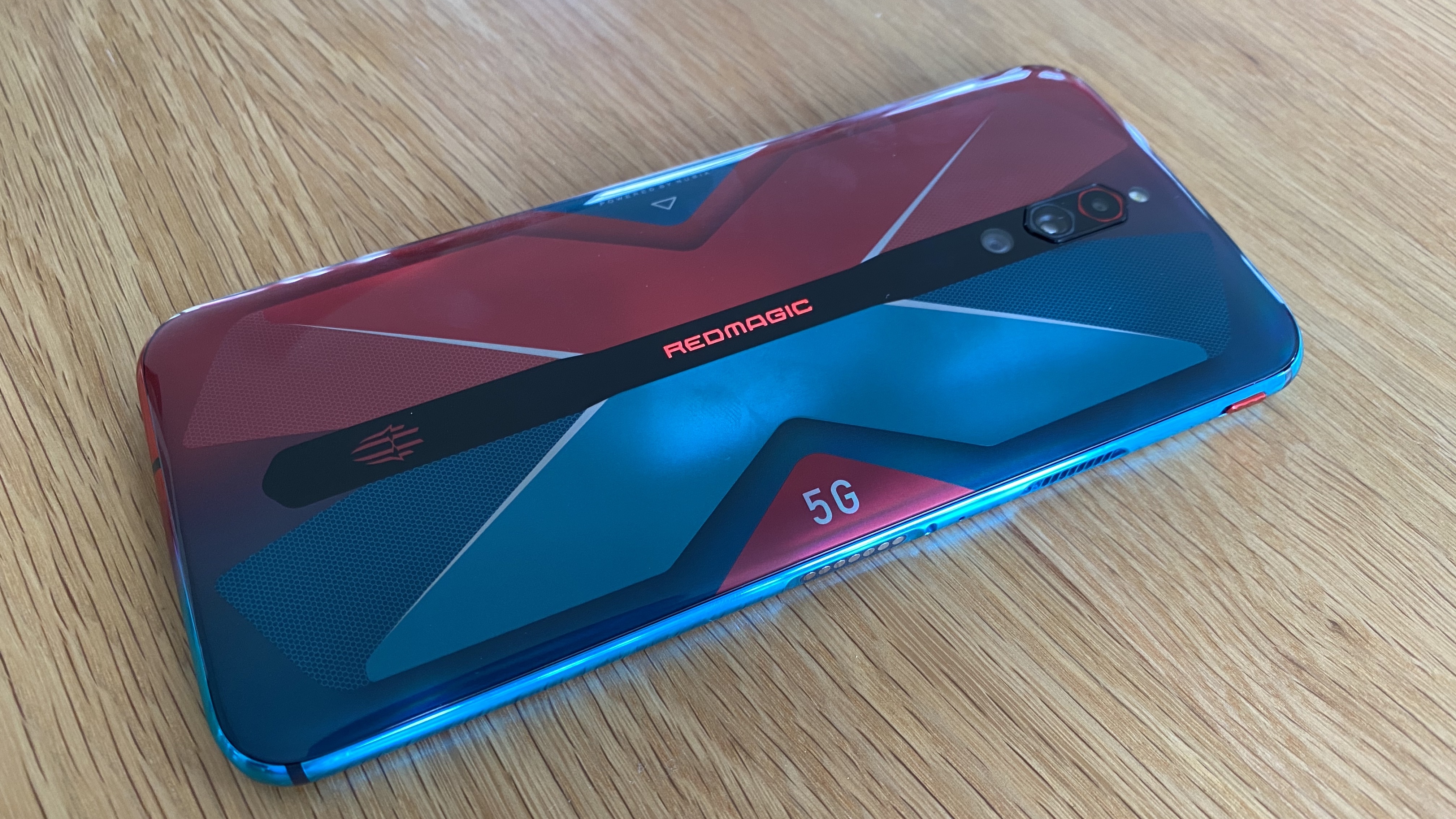
Around the edges you find the usual power button and volume buttons on the right side, and the SIM tray and USB-C port on the bottom. But also on the right, you'll see the RedMagic 5G's two capacitive trigger buttons for gaming, and one of two openings for the built-in cooling fan (the other being on the left side next to the Game Boost switch and the external peripheral connector). A final small treat can be found on the top: a headphone jack, much to the relief of anyone who's yet to invest in a pair of the best wireless headphones.
The front is the weakest part of the phone's overall image. The top and bottom bezels are particularly large, making the phone look a few generations out of date. However, that means there's no notch breaking up the display, which is exactly what you don't want when gaming.
A design factor that may also affect some people is the phone's size and weight. This is one of the largest and heaviest phones we've tested this year, measuring almost the same in length, width and height as the Samsung Galaxy S20 Ultra while weighing more. You'll need big pockets to carry the RedMagic around, and a tolerance for that 218g (7.68 ounces) mass every time you pick it up to use it.

RedMagic 5G display
The RedMagic 5G's display is only interested in one thing – maximum frame rate. That's why this 6.65-inch AMOLED panel bears the title of first production phone with a 144Hz display, a cut above the 120Hz refresh rate that became commonplace for Android flagships this year. It's noticeable too, as swiping through menus or watching content on RedMagic’s phone looks a touch smoother than on the 120Hz panel of the OnePlus 8 Pro.
What you gain in extra frames, you lose elsewhere though. The RedMagic 5G’s display is only FHD rather than the flagship-standard QHD, and it's bordered at the top and bottom by heavy bezels in order to avoid spoiling the view with a camera notch. There are no curved edges either, like you'd find on the OnePlus 8 Pro or Huawei P40 Pro, but I don't really miss them.
The display is also a little dim. It's rated at a maximum of 600 nits, but peaked at only 429 nits in our testing. That's a long way off the 847-nit rating of the Samsung Galaxy S20 Plus. I was able to use the RedMagic 5G outdoors without a problem, but perhaps you should avoid using it in direct sunlight if you want to make sure you don't miss out on anything happening on screen.
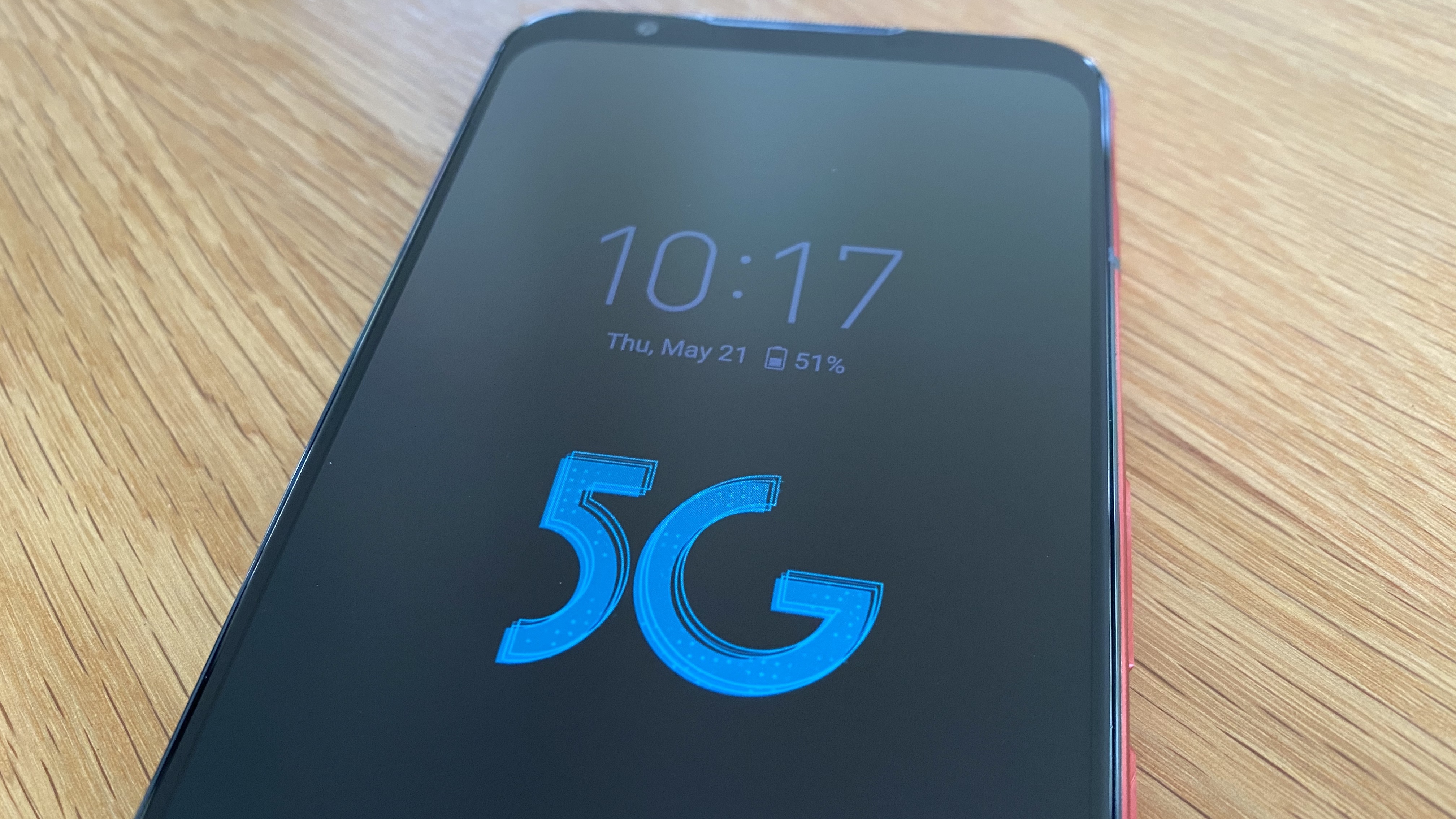
We also tested the phone's panel for color quality, finding that it achieves 180% of the sRGB color gamut, 128% of the trickier DCI-P3 color gamut and a color accuracy score (Delta-E) of 0.30. That's a step above the OnePlus 8 Pro's scores of 165% and 117%, respectively, but RedMagic’s device loses out on color accuracy, beaten by the OnePlus' 0.26 rating. (Zero is a perfect score.)
Watching JoJo's Bizarre Adventure: Stardust Crusaders on the 5G was a mixed quality experience. I liked the way the phone made the bright colors of this vividly-inked anime pop out, however the FHD resolution was not as clear as rival QHD displays, as you would expect. The worst aspect were the speakers, which are a little underpowered despite this being a stereo setup. Fortunately, this is easy to ignore once you put on a pair of headphones, which is easy to do since there's still a headphone jack to plug into.
RedMagic 5G cameras
Gaming phones aren't focussing on the quality of pictures you can take with them, but they're still important to most phone users. RedMagic hasn't completely skimped on sensors either, since the RedMagic 5G offers a very large 64-megapixel main camera, backed up with an 8-MP ultrawide camera and 2-MP macro camera, alongside an 8-MP front camera.
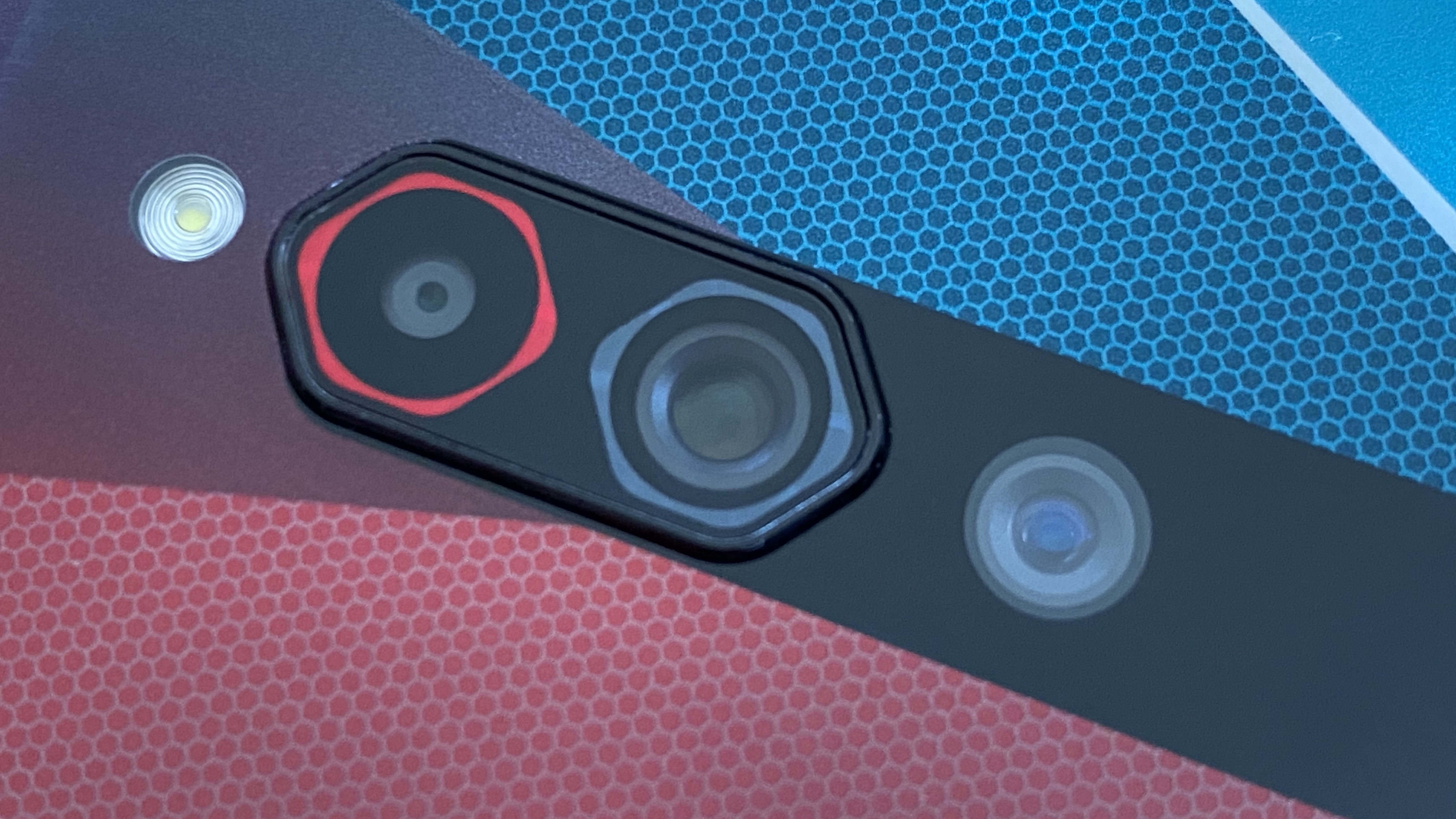
The following comparisons are made against the OnePlus 8 Pro, which isn't ranked as our best camera phone of the moment. For Android devices, that distinction actually goes to the Samsung Galaxy S20 Plus. Yet OnePlus’ flagship costs closer to the RedMagic 5G, and takes decent enough pictures to serve as a suitable benchmark.
Testing the two main cameras first during a trip to a local beach, the RedMagic gets off to a good start with its 64MP resolution beating the 48MP resolution of the OnePlus. I can't pick out a strong preference here, which arguably is a condemnation of the 5G's poorer image processing letting the OnePlus close the quality gap, but this is still a good result for the RedMagic phone.
But the RedMagic pulls ahead when we go in for a close-up of a starfish, washed up on the shore. The bumps and corners of the five-pointed fish look brighter and more colorful on the 5G, although the OnePlus does seem to render a slightly sharper image.
When the sun goes down, the OnePlus 8 can show off its Nightscape mode, which works pretty well in illuminating this tree just after sunset. The RedMagic does have a night mode too, but it's far less effective, with the image lacking essential color and detail.
Switching to the ultrawide cameras, the RedMagic's 8MP sensor struggles to compete against the OnePlus's 48MP sensor. The image from the gaming phone is significantly darker, which not only fails to accurately depict the colors of the scene but also causes the furthest parts of the background to start blending into the sky. It's a no-contest round in the OnePlus' favor.
A 2-MP macro lens is the RedMagic’s final rear camera. This is a cost-effective way for phone makers to add an extra photography option to their devices, but it's incredibly hard to get a decent shot out of these tiny sensors, and this one is no exception. This image of a flower did turn out quite well, but it took me at least 10 attempts to get a picture I was happy with, and this shot likely would have turned out just as nice using the main sensor.

The final test compares the 8MP front camera of the RedMagic against the OnePlus' 16MP sensor. The 5G produces an OK image, but it pales in comparison to the OnePlus 8 Pro’s, which is superior in detail, color and in creating a portrait effect for the background.
The RedMagic 5G won't be getting a spot on our list of best camera phones, but rest assured it has the bases covered when it comes to selfies and standard main sensor photos, and is at least capable of ultrawide images if you don't have a better camera available. The macro sensor is still unnecessary though.
RedMagic 5G performance
In terms of its specs, the RedMagic is as good as any other recent Android flagship with its Snapdragon 865 chipset backed up by 12GB of RAM.
On Geekbench 5, it achieved 899 points in the single core test and 3,243 in the multi-core test. It's still way behind the iPhone 11 Pro Max's scores of 1,334 and 3,517 respectively, as all Android phones are. It's also a little behind the OnePlus 8 Pro, which uses the same CPU and amount of RAM and scored 906 and 3,379 points, respectively.
The competition tightens up on graphics. Both the OnePlus 8 Pro and the RedMagic 5G managed 20fps on the GFXBench 1440p Aztec Ruins OpenGL offscreen test, with the iPhone 11 Pro Max reaching 25 fps. This is a great achievement for a phone that costs $650, and cements the RedMagic's reputation for providing lots of bang for relatively little buck.
My own general usage supported this. Playing Asphalt 9: Legends didn’t seem to tax the RedMagic 5G much, and thanks to the phone’s cooling fan, the glass back barely heated up even after a full 20 minutes of playtime.
RedMagic 5G battery life and charging
You get a fairly standard 4,500-mAh battery in the RedMagic 5G — identical in size to the Samsung Galaxy S20 Plus and just a little smaller than the OnePlus 8 Pro's 4,510 mAh cell. RedMagic’s phone uses that power very efficiently though. At the lowest 60Hz display refresh rate, you get 11 hours and 23 minutes, which crushes the Samsung Galaxy S20 Plus' lifespan of 10 hours and 31 minutes by nearly an hour and also beats the 11 hours and 5 minutes achieved by the OnePlus 8 Pro.
At the maximum 144Hz, that longevity is reduced to 8 hours and 53 minutes. That's precisely two minutes less than the Galaxy S20 Plus (8:55) and nine minutes less than the OnePlus 8 Pro (9:02), but those devices max out at 120Hz instead (and the S20 Plus was at FHD resolution instead of QHD, too), so you're getting a little extra smoothness for a little less battery life, which I think is worth the tradeoff.
The RedMagic 5G comes with an 18W charger in the box, which during my own testing filled the phone up to 30% in half an hour of charge time. That's OK, though hardly impressive. However, the phone does support up to 55W charging with other charging blocks. Using a 65W laptop charger, I was able to charge the 5G up to 77% in 30 minutes, with the phone offering the option to turn on its internal fan to help manage the high temperatures caused by all that wattage. It's a pity RedMagic doesn't include a more powerful adapter in the box, but it's good to know that you can get excellent charging performance by plugging it into your laptop charger, saving you time and space in your bag.
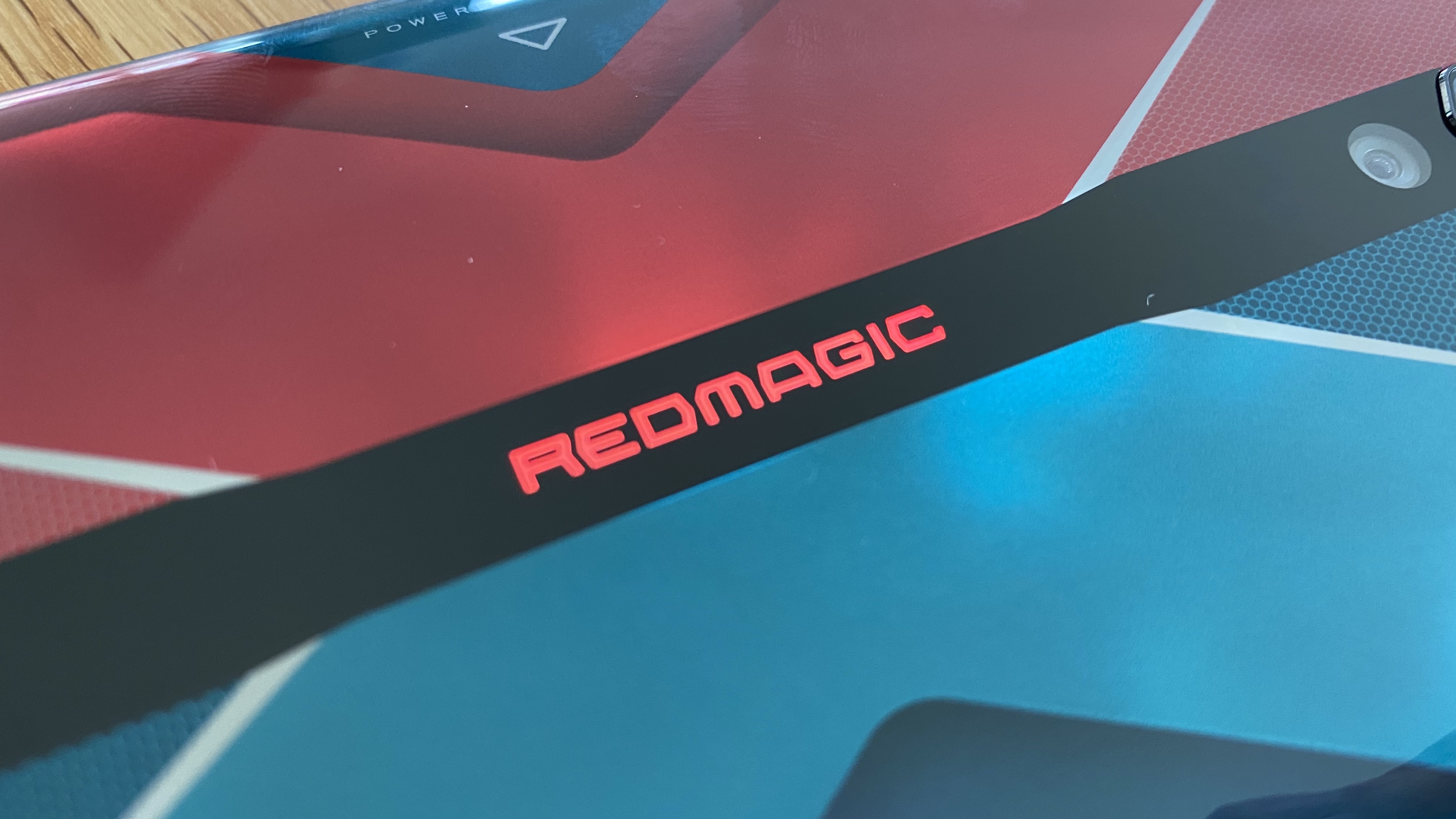
RedMagic 5G connectivity
As you might have guessed from the name, the RedMagic 5G is 5G compatible thanks to the Qualcomm X55 modem that comes with the Snapdragon 865 chipset. It is only sub-6Ghz 5G though, so tough luck if your carrier’s 5G network uses mmWave.
Nevertheless, if you're in the U.K., you'll be able to enjoy the speed and reliability of 5G on the RedMagic, which will prove very handy for multiplayer online gaming while out and about. U.S. customers should note, however, that the RedMagic 5G only supports 5G bands n41 and n78, which in the U.S. are exclusively used by Sprint and T-Mobile — making this device’s 5G compatibility quite slim.
RedMagic 5G software and special features
The 5G runs on Android 10 in the guise of RedMagic OS 3.0, which I don't find to be a particularly attractive version of Android — though it’s certainly lightweight. There is a small handful of Nubia-made apps for email, contacts, calendars, notes, photos, sound recording, clocks and alarms, file management and for fiddling with the phone's always-on display, but that's about it, aside from the standard suite of Google-made apps like Gmail and YouTube.
I really don't like typing on the 5G. The default haptic feedback is too buzzy, likely because it's tuned for in-game feedback rather than for a virtual keyboard. Another sticking point is the spelling mistakes or strangely worded phrases found in various places around the menus. This would be very easy for RedMagic to fix with an OTA update, and perhaps won't be present on the units available for consumer purchase anyway. But it does leave an unpleasant impression that Nubia's not quite filed off all the rough edges.
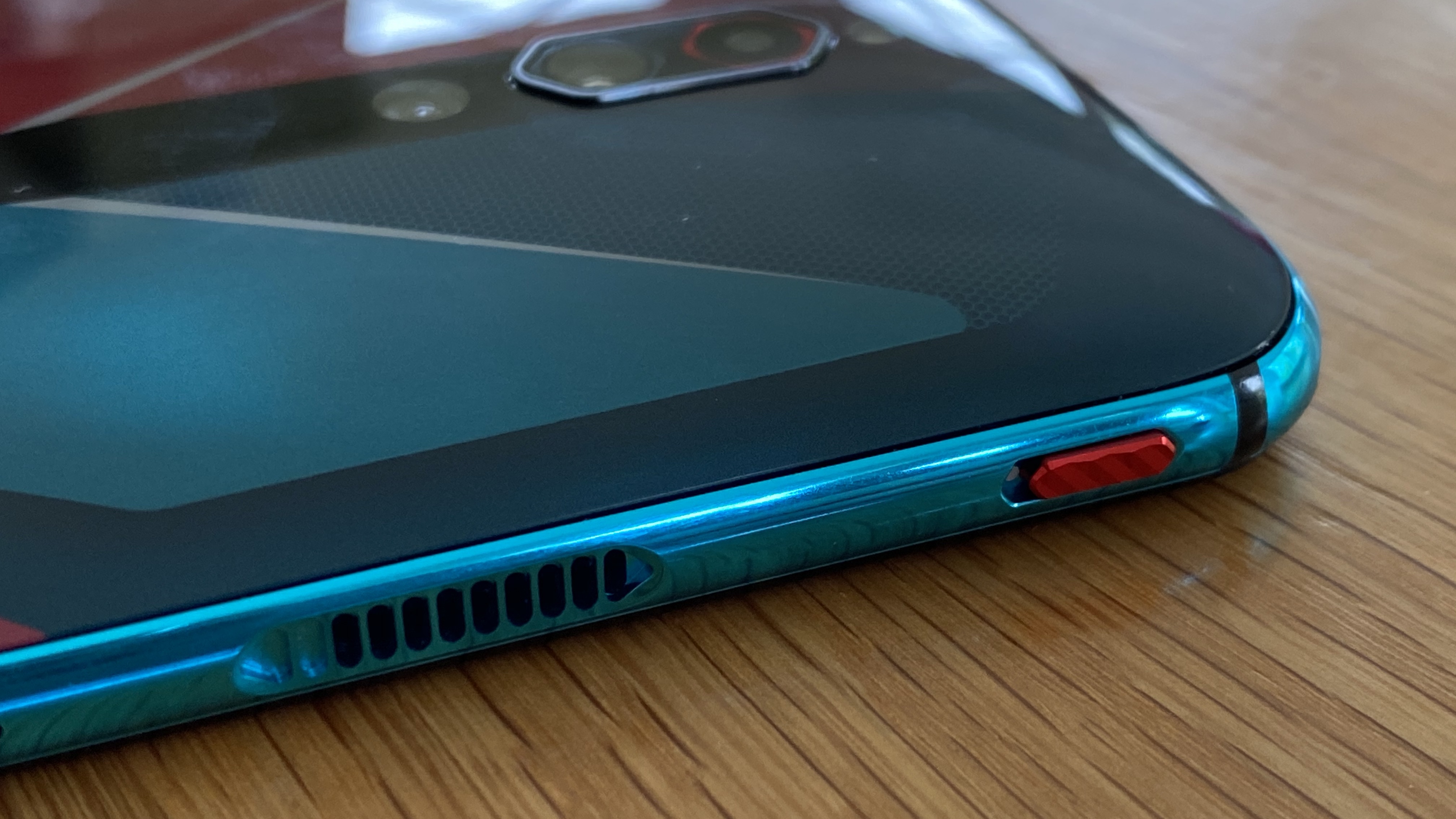
Activating Game Space by sliding the dedicated switch at the top of the phone's left edge takes you into a new interface and activates the phone's fan. Here, you can scroll through all your games (keeping them off the home screen unless you want them there), change the settings for the fan and the RGB lighting, browse in-game screenshots and clips, disable notifications to eliminate potential interruptions, set up a peripheral or controller and adjust a whole bunch of other options.
Setting up a separate space for certain apps is something you can achieve on most Android phones if you know where to look in the options menu, but the Red Magic 5G puts this front and center along with several other customization options that mobile gamers are going to want quick access to.
The fan itself is a first for smartphones. While it does mean that a section of the interior of the phone has to be left open to the elements (hence no IP water/dust resistance rating), it also keeps the phone cool quite effectively. At normal speed, the sound is pretty quiet, and can be covered up just by playing some audio. At full power, which you can turn on manually in Game Space, it's much louder, requiring headphones to block out the noise — and no doubt irritating anyone in the same room as you.
Also part of the phone's gamer-oriented feature set are the capacitive trigger buttons on the right-hand side. Since they're not mechanical, they don't feel too out of place when you're using the phone normally. When the time comes for games, you can quickly set these up to mimic an in-game action by registering them to virtually tap a certain portion of the display, like a fire button or accelerator. You get a short blast of haptic feedback when you interact with the triggers as well, which helps these stationary buttons feel more substantial to use and quite satisfying to tap.
Bottom line
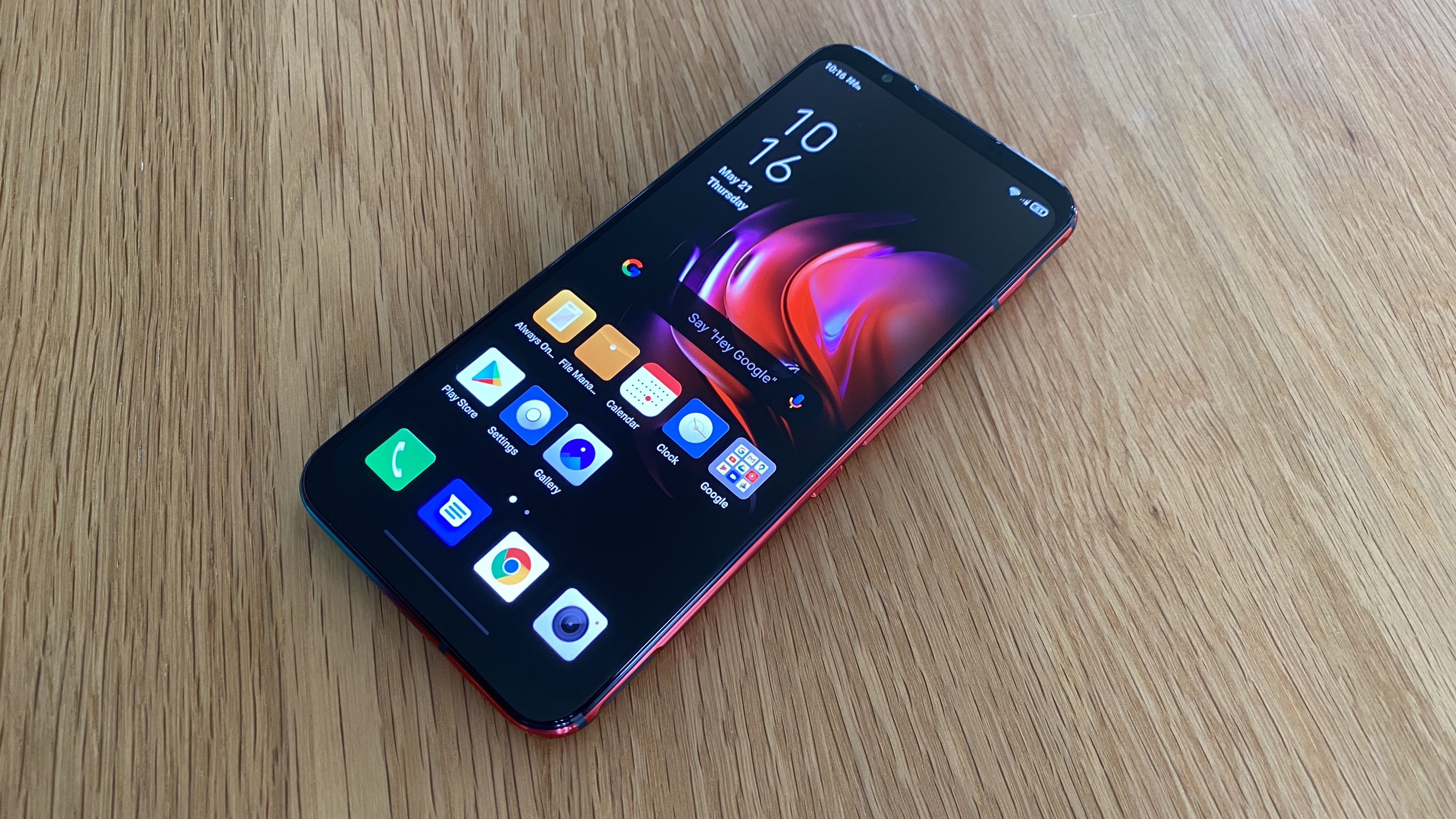
Offering plenty of performance for a relatively low price, the RedMagic 5G is the smartphone equivalent of a tuned-up family sedan. Its loud colors, large bezels and internal fan will surely put some people off, like a particularly unsubtle spoiler and body kit mod. But if you are even just indifferent to the design, the Red Magic 5G is still worth keeping on your shortlist next time you look for a flagship-level Android phone, thanks to its sheer value.
What you'll lose by buying the RedMagic 5G is a high-quality design and user experience. While this phone excels with its class-leading refresh rate and chipset/memory combination, the lower-resolution display and uninspired software can't compete with more established brands' better components and more intuitive versions of Android — although RedMagic gets a thumbs up for not going crazy with bloatware. I won't recommend the RedMagic 5G over the OnePlus 8 Pro for the majority of users, but I will happily endorse it as a potential flagship slayer for those charmed by its eccentricities, or gamers searching for a phone with an aesthetic as singular as a streak of perfectly-executed headshots in PUBG.

Richard is based in London, covering news, reviews and how-tos for phones, tablets, gaming, and whatever else people need advice on. Following on from his MA in Magazine Journalism at the University of Sheffield, he's also written for WIRED U.K., The Register and Creative Bloq. When not at work, he's likely thinking about how to brew the perfect cup of specialty coffee.
